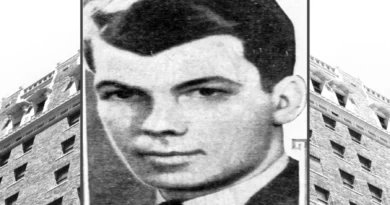Nadia Kersh Disappearance in Homewood Alabama
Nadia Kira Kersh was born in July 1985 and raised in Homewood, Alabama. The daughter of immigrant parents, she grew up fluent in Russian and English, blending traditions from her family’s heritage with Southern hospitality. From a young age, Nadia demonstrated responsibility beyond her years—balancing schoolwork, part-time jobs babysitting neighborhood children, and caring for her younger brother. Those who knew her remembered a warm smile, an easy laugh, and a protective nature: she seldom refused a request for help, whether it was tutoring a classmate or volunteering at church bake sales. After graduating from Homewood High School, Nadia enrolled at the local community college while working full time as a cashier at Tria Market to support herself and her infant son.
Life in Homewood and Community Ties
Homewood is a close-knit suburb of Birmingham, known for tree-lined streets, strong neighborhood bonds, and family-oriented events. Nadia embodied the spirit of that community—she knew most of her customers by name, stopped to chat with neighbors on evening walks, and acted as a pillar for single parents she befriended at daycare drop-off lines. She attended weekly Bible study sessions, maintained friendships spanning decades, and organized play dates for her son in the local park. Her life was woven into the daily rhythms of Homewood: from Little League games to summer block parties, Nadia was present, engaged, and trusted.
The Morning of November 3, 2008
On Monday, November 3, 2008, Nadia followed her usual routine. After dropping her son at daycare, she clocked in for the day shift at Tria Market on Green Springs Highway. Colleagues described her as focused and upbeat, remarking that she greeted each customer with genuine warmth. She rang up groceries, stocked shelves during slow periods, and handled cash transactions with practiced efficiency. Shortly before 1:00 p.m., having completed her tasks and longing for a quick reunion with her child, she asked her supervisor if she could leave early to pick him up. Permission granted, she clocked out, waved goodbye, and exited the store to head down to the attached parking garage.
The Disappearance Unfolds
Surveillance footage captured Nadia stepping out of the store entrance and approaching the garage elevator. She rode down one level, doors opening to reveal her red Chrysler Sebring convertible parked under the fluorescent lights. She carried her trademark oversized jacket and her purse, which contained her wallet, cell phone, and keys. She never faded from view on camera leaving the vehicle or walking back toward the exit hallway. Within twenty minutes of her disappearance, her absence remained unnoticed—her son’s teacher assumed she would run late, and her manager believed she was taking a brief personal call. It wasn’t until she failed to arrive at the daycare at 1:30 p.m. that alarm bells rang.
Discovery of Abandoned Belongings
When Nadia did not appear to pick up her son, daycare staff contacted her emergency list; her mother’s phone went unanswered. Homewood police were notified around 2:00 p.m., and officers arrived at the Tria Market garage within minutes. They found her Chrysler Sebring parked precisely where Nadia left it, engine off, driver’s door closed. The vehicle appeared undisturbed—no signs of struggle or forced entry. Three days later, a passerby discovered Nadia’s purse tucked beneath an overpass on Montevallo Road, several miles from the market. The purse’s contents remained intact except for her car keys. This only deepened the mystery: the separation of keys and car suggested someone moved the vehicle intentionally, yet Nadia herself vanished without a trace.
Initial Police Response and Investigation
Homewood Police Department mobilized detectives who scoured the garage, photographing tire tracks and collecting surveillance video from surrounding businesses. Crime-scene technicians dusted the vehicle for fingerprints and DNA, and K-9 units were deployed to follow any scent trail. Witness canvases included fellow shoppers, delivery drivers, and a security guard who patrolled the garage. Leads surfaced quickly—anonymous tips of a suspicious man loitering near the elevators, reports of a late-model black sedan circling the lot—but each fizzled after verification. Detectives interviewed Nadia’s coworkers, neighbors, and friends, constructing a timeline that ended abruptly at 1:05 p.m., the last confirmed sighting of Nadia on camera.
Family Involvement and Public Appeals
On the evening of November 5, Nadia’s family held a press conference outside Tria Market. Tearful but resolute, her mother implored anyone with information—no matter how small—to come forward. Flyers bearing Nadia’s photograph appeared on utility poles, and local television stations broadcast news segments recounting her disappearance. Community volunteers staffed a 24-hour hotline, while faith groups organized prayer vigils. Her son, then three years old, became the human face of the tragedy; community fundraisers collected money for family expenses, underscoring the profound bond between Nadia and her home town.
Media Coverage and National Attention
Within weeks, national outlets picked up Nadia’s story. True-crime blogs detailed the baffling circumstances of her vanishing, emphasizing the separation of her car and personal items. Crime-documentary programs filmed re-enactments of the garage timeline, while talk-radio hosts debated potential foul play scenarios. Cold-case newsletters built up online archives, enabling distant readers to sift through public records, court documents, and crime-scene photos. Despite this surge in awareness, no solid leads surfaced; the disconnect between public fascination and investigative breakthroughs remained stark.
Suspect, Charge, and Legal Hurdles
Two years after Nadia’s disappearance, an ex-boyfriend—who lived near the overpass where her purse was found—became a person of interest. He had no alibi for November 3, 2008, and cell-phone records placed him in proximity to the Montevallo Road spot days later. In May 2010, prosecutors charged him with capital murder and burglary, alleging he broke into Nadia’s home that night and panicked when confronted. He spent fifteen months in the county jail awaiting trial, but in August 2011, a judge dismissed the indictment. The ruling cited violations of the state’s speedy-trial statute and preservation-of-evidence protocols: forensic samples were delayed in testing, and key discovery documents were not timely disclosed to the defense. Though released without prejudice, the defendant remained under informal scrutiny, with prosecutors retaining the right to refile should new evidence emerge.
Forensic Advances and Cold-Case Review
As forensic science leapt forward in the early 2010s, Homewood detectives revisited Nadia’s case file. They submitted latent fingerprints from her car to updated AFIS databases, re-extracted DNA swabs from the driver’s seat, and employed new genealogical search techniques to cross-reference possible familial matches. Investigators also reinterviewed witnesses with refreshed cognitive-interview protocols—techniques proven to elicit more accurate memories. Despite these efforts, the case remains unsolved. Yet each technological advance kindled hope: from enhanced cellphone tower data analysis narrowing suspect movements to refined soil-particle comparison on garage floor debris.
Community Efforts to Keep Nadia’s Memory Alive
Homewood residents honored Nadia’s legacy by establishing an annual “Light the Night” vigil in November. Attendees release lanterns and share stories of her kindness, while local businesses donate proceeds to missing-persons support groups. Schools incorporate Nadia’s story into personal-safety curriculums, teaching students the importance of staying with companions and using verified ride services. A scholarship fund in her name assists single parents pursuing education, ensuring that her generous spirit continues to uplift others.
The Toll on Family and Friends
Fifteen years after her disappearance, Nadia’s parents cope with enduring uncertainty. Her mother continues to maintain Nadia’s bedroom exactly as it was on that November day—fresh flowers on the dresser, toys on the shelf, and the red Chrysler Sebring keychain hanging on the wall. Friends describe anniversaries as days of quiet reflection and solidarity, gathering at the overpass where her purse was found to lay flowers and balloons. Her son, now grown, carries both gratitude and grief: grateful for the community that raised him, grieving the mother he barely remembers.
Lessons Learned and Ongoing Challenges
The Kersh case highlights enduring challenges in missing-persons investigations: timely evidence processing, clear communication between agencies, and balancing public interest with procedural rigor. It underscores the need for specialized cold-case units with dedicated funding and access to the latest forensic tools. Moreover, it serves as a reminder that every missing-person report represents a family’s nightmare, requiring not only law-enforcement expertise but also sustained community support.
Looking Ahead: Hope for Resolution
Despite the passage of time, investigators stress that no case is ever closed. New tips—whether from someone with a long-held secret or from accidental recollections during unrelated conversations—can unlock breakthroughs. Homewood Police Department encourages anyone who worked at Tria Market, frequented the garage, or traveled Montevallo Road in November 2008 to revisit old memories. They maintain a confidential tip line and pledge to follow up diligently. For Nadia’s family and the wider community, each lead, each memory, and each act of remembrance kindles hope that one day the full story of November 3, 2008, will finally come to light.
Discover more from City Towner
Subscribe to get the latest posts sent to your email.




